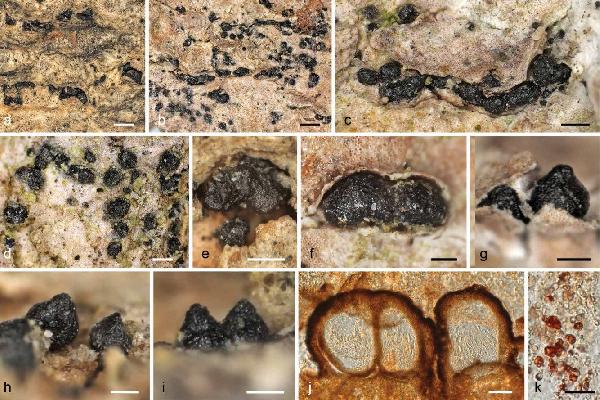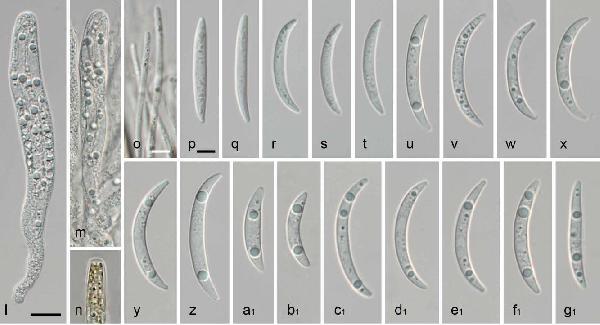Leptosillia muelleri (Duby) Voglmayr & Jaklitsch
in Voglmayr & al., Persoonia, 42: 247, 2019. Basionym: Sphaeria muelleri Duby - in Rabenhorst, Klotzschii Herb. Viv. Mycol., Edn Nov, Ser. Sec., Cent. 7: no. 642, 1857
Synonyms: Cresporhaphis muelleri (Duby) M.B. Aguirre; Harpostroma nothum (Sacc.) Höhn.; Leptorhaphis aggregata Eitner; Leptorhaphis wienkampii var. aggregata (Eitner) Keissl.; Leptosillia notha Höhn.; Leptosphaeria muelleri (Duby) Auersw.
Distribution:
Description: Thallus inapparent, not lichenized, developing on bark scales of Acer. Perithecia black, matt, embedded in a pseudostroma, emerging from cracks of bark scales, (0.1-)0.14-0.21(-0.26) μm across, smooth, usually confluent and then irregular in shape and c. 1 mm long, half-immersed in bark, not collapsing, with an indistinct to distinct central apical papilla. Exciple continuous, of a textura angularis, composed of an outer dark brown to black, 10-30(-45) μm thick layer of thin-walled isodiametrical cells with dark brown walls, forming a pseudostroma surrounding the inner wall, and an inner, 12-20 μm thick subhyaline to pale brown layer of (sub)hyaline to light brown, slightly smaller and sometimes radially compressed cells. Paraphyses hyaline, Asci 8-spored, cylindrical, unitunicate, thin-walled, without a distinct apical apparatus. Ascospores 1-celled, hyaline, fusiform, lunate to falcate- (20-)25-33(-38) x (2-)2.8-3.7(-4.7) μm, thin-walled, smooth, with subacute to narrowly rounded tapering ends, guttulate. Pycnidia black, usually confluent, resembling perithecia. Conidia of two types: a) holoblastic, falcate, hyaline, smooth, with narrowly rounded ends, with few small guttules, 21-27(-32) x 2-2.5(-3) μm, b) enteroblastic, filiform, curved to semi-circular, (19-)23-28(-31) x (0.8-)0.9-1.2(-1.4) μm. Photobiont absent. Spot tests: all negative. Chemistry: without lichen substances.Note: on bark scales of mature living trees of Acer pseudoplatanus; known from Austria, Czech Republic, France, Germany, Poland, and Switzerland; to be looked for in Italy.
Growth form: Fungus
Substrata: bark
Reproductive strategy: mainly sexual
Pioneer species

Predictive model

Source: Voglmayr H., Aguirre-Hudson M.B., Wagner H.G., Tello S., Jaklitsch W.M. 2019. Lichens or endophytes? The enigmatic genus Leptosillia in the Leptosilliaceae fam. nov. (Xylariales), and Furfurella gen. nov. (Delonicicolaceae). Persoonia, 42: 228–260. - CC BY-NC-ND 3.0
Leptosillia muelleri, sexual morph. a–i. Single and confluent perithecia on bark in surface (a–f) and side (g–i) view; j. vertical section through pseudo-
stroma with perithecia; k. strongly dextrinoid granular hamathecial exudates in Lugol after KOH pre-treatment; l–m. asci; n. ascus tip in Lugol; o. paraphyses;
p–g1. ascospores (p–t. dead, u–g1. vital). All in water, except where noted (a, e, j, p–t: FH 00304540 (holotype of Leptosillia notha); b–c, f–g, l, o, u, y–z:
WU 40005 (epitype); d, h, n, v–x: WU 40006; i, m, a1–b1: WU 40007; k, c1–g1: WU 40008). — Scale bars: a–b = 500 μm; c–e = 200 μm; f–i = 100 μm;
j = 50 μm; k–n = 10 μm; o–g1 = 5 μm

Source: Voglmayr H., Aguirre-Hudson M.B., Wagner H.G., Tello S., Jaklitsch W.M. 2019. Lichens or endophytes? The enigmatic genus Leptosillia in the Leptosilliaceae fam. nov. (Xylariales), and Furfurella gen. nov. (Delonicicolaceae). Persoonia, 42: 228–260. - CC BY-NC-ND 3.0
Leptosillia muelleri, sexual morph. a–i. Single and confluent perithecia on bark in surface (a–f) and side (g–i) view; j. vertical section through pseudo-
stroma with perithecia; k. strongly dextrinoid granular hamathecial exudates in Lugol after KOH pre-treatment; l–m. asci; n. ascus tip in Lugol; o. paraphyses;
p–g1. ascospores (p–t. dead, u–g1. vital). All in water, except where noted (a, e, j, p–t: FH 00304540 (holotype of Leptosillia notha); b–c, f–g, l, o, u, y–z:
WU 40005 (epitype); d, h, n, v–x: WU 40006; i, m, a1–b1: WU 40007; k, c1–g1: WU 40008). — Scale bars: a–b = 500 μm; c–e = 200 μm; f–i = 100 μm;
j = 50 μm; k–n = 10 μm; o–g1 = 5 μm
Growth form: Fungus
Substrata: bark
Reproductive strategy: mainly sexual
Pioneer species

Predictive model

Source: Voglmayr H., Aguirre-Hudson M.B., Wagner H.G., Tello S., Jaklitsch W.M. 2019. Lichens or endophytes? The enigmatic genus Leptosillia in the Leptosilliaceae fam. nov. (Xylariales), and Furfurella gen. nov. (Delonicicolaceae). Persoonia, 42: 228–260. - CC BY-NC-ND 3.0
Leptosillia muelleri, sexual morph. a–i. Single and confluent perithecia on bark in surface (a–f) and side (g–i) view; j. vertical section through pseudo- stroma with perithecia; k. strongly dextrinoid granular hamathecial exudates in Lugol after KOH pre-treatment; l–m. asci; n. ascus tip in Lugol; o. paraphyses; p–g1. ascospores (p–t. dead, u–g1. vital). All in water, except where noted (a, e, j, p–t: FH 00304540 (holotype of Leptosillia notha); b–c, f–g, l, o, u, y–z: WU 40005 (epitype); d, h, n, v–x: WU 40006; i, m, a1–b1: WU 40007; k, c1–g1: WU 40008). — Scale bars: a–b = 500 μm; c–e = 200 μm; f–i = 100 μm; j = 50 μm; k–n = 10 μm; o–g1 = 5 μm

 INDEX FUNGORUM
INDEX FUNGORUM
 GBIF
GBIF


